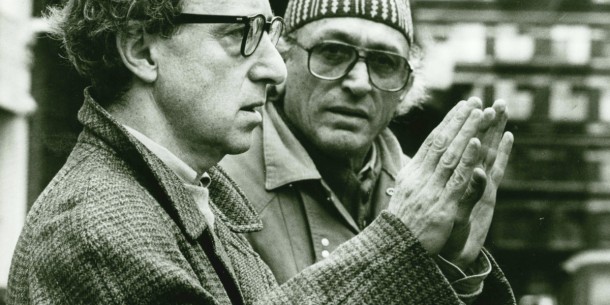
Dir.: Fariborz Kamkari; Documentary with Carlo Di Palma, Woody Allen, Vittoria De Sica, Wim Wenders, Ken Loach; Italy 2017, 90 min.
Director of Photography Carlo Di Palma (1925-2004) was one of the most influential DoPs of the second half of the 20th century, and instrumental in the careers of Michelangelo Antonioni and Woody Allen. His story is told in this compelling documentary from Fariborz Kamkari and Adriana Chiesi-Di Palma, who married the photographer in the mid-1980s, and conducts the interviews with Woody Allen and Ken Loach about their time with Carlo, making the tribute feel all the more intimate and personal.
Di Palma spent his early days in Rome where his mother, a flower-seller, popped him on the tram when it rained, and the drivers would give him water and sugar to cheer him up. Opposite his primary school was a film studio where his brother worked as a focus operator and Carlo joined him, as a teenager, working on Visconti’s first feature Ossessione. His job was to get the film stock from an allied soldier – a certain Sven Nykist, and later he joined the crew on Rossellini’s Rome, Open City as the most junior of all the camera assistants”.
Apart from the talking heads: Allen, Loach, Bertolucci et al, WATER AND SUGAR is enriched with excerpts from Di Palma’s many films, starting with De Sica’s Bicycle Thieves, where he worked as a camera operator and assistant, until he was finally promoted to DoP in Lauta Mancia in 1957, directed by Fabio de Agostini. His first success was It happened in ’43, a WWII drama, directed by Florestano Vancini. In 1964, he shot the first of three films for Michelangelo Antonioni: Red Desert with Monica Vitti; Blow Up (1966); Identification of a Woman (1982) would follow. The two first two features were very much known for their stunning colour photography. “Black and white is a transformation of reality. But in colour the reality became too realistic, so we, like painters, have to cut the colours, to try and let them not dominate the technique”. But it was for Di Carlo’s personal touch that he was unique and special. Ken Loach tells how Di Palma and his contemporary DoPs all started with monochrome, so using colour was very exciting, “and this excitement could be felt in the images”. When shooting Blow Up in the summer of 1965, the grass turned yellow and had to be repainted green every day. Di Palma remembers:“Everybody in England looked at us as if we were mad”. But for Wim Wenders, Blow Up was a seminal experience: “Blow Up showed me how important colours were, because he showed them in an innovative way. He dealt with the essence of taking a picture”.
Between 1973 and 1976 Carlo Di Palma directed three feature films: one of them, Theresa the Thief, starring Monica Vitti, run into difficulties because Di Palma and Vitti’s relationship was coming to an end. In 1981 Di Palma would photograph Tragedy of a Ridiculous Man for Bernardo Bertolucci. Interviewed about their relationship, Bertolucci amusingly recalls: “Vittorio Storaro is my wife, Carlo Di Palma is my lover. The only time I did not work with Storaro, was when I worked with Di Palma. So this work is like the memory of falling in love”.
When Woody Allen was shooting his first film Take the Money and Run, he had just seen Blow Up and desperately wanted Di Palma to shoot it, but he wasn’t available. Nearly ten years later, in 1986, Allen and Di Palma finally got together in a collaboration marked by its easy friendship and camaraderie – they lived their whole lives together: “We worked and then had lunch; worked more and then had dinner”. Their first film together was Hannah and her Sisters in a collaboration that would last until 1997 (Reconstructing Harry). Allen was exuberant after their cooperation: “Carlo lived up to all our expectations.” Di Palma was also happy in New York: “it is a city where I can live like in Rome. But Los Angeles and New York are totally different. I could never work in Hollywood. You only use a storyboard as a tool there – the only creativity in Hollywood happens on the drawing board”.
Di Palma “loved warm colours, like the paintings in Italy”. He went to the Sistine Chapel as a boy, and later filmed the restoration of the place. But he was foremost a poet who filmed like a painter, yet always subjugating himself to the director and the script, “because some directors shoot their own film, not the one which is scripted. But it will be always the same film, perhaps even extraordinary, but the photography will always be the same”. Nobody could ever say this about Carlo Di Palma’s work: this documentary is a remarkable portrait not only of his monumental output but also his genuine warmness as a human being that made all who worked with him even better. AS
NOW ON RELEASE AT SELECTED ARTHOUSE CINEMAS FROM 21 JULY 2017
https://vimeo.com/202017377